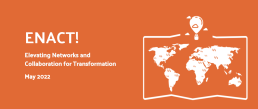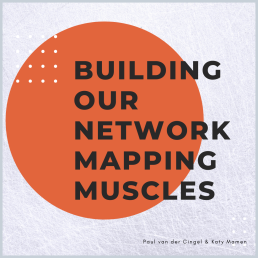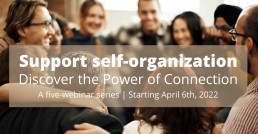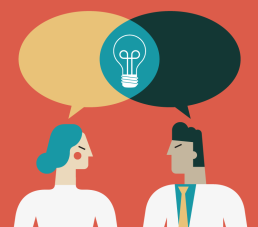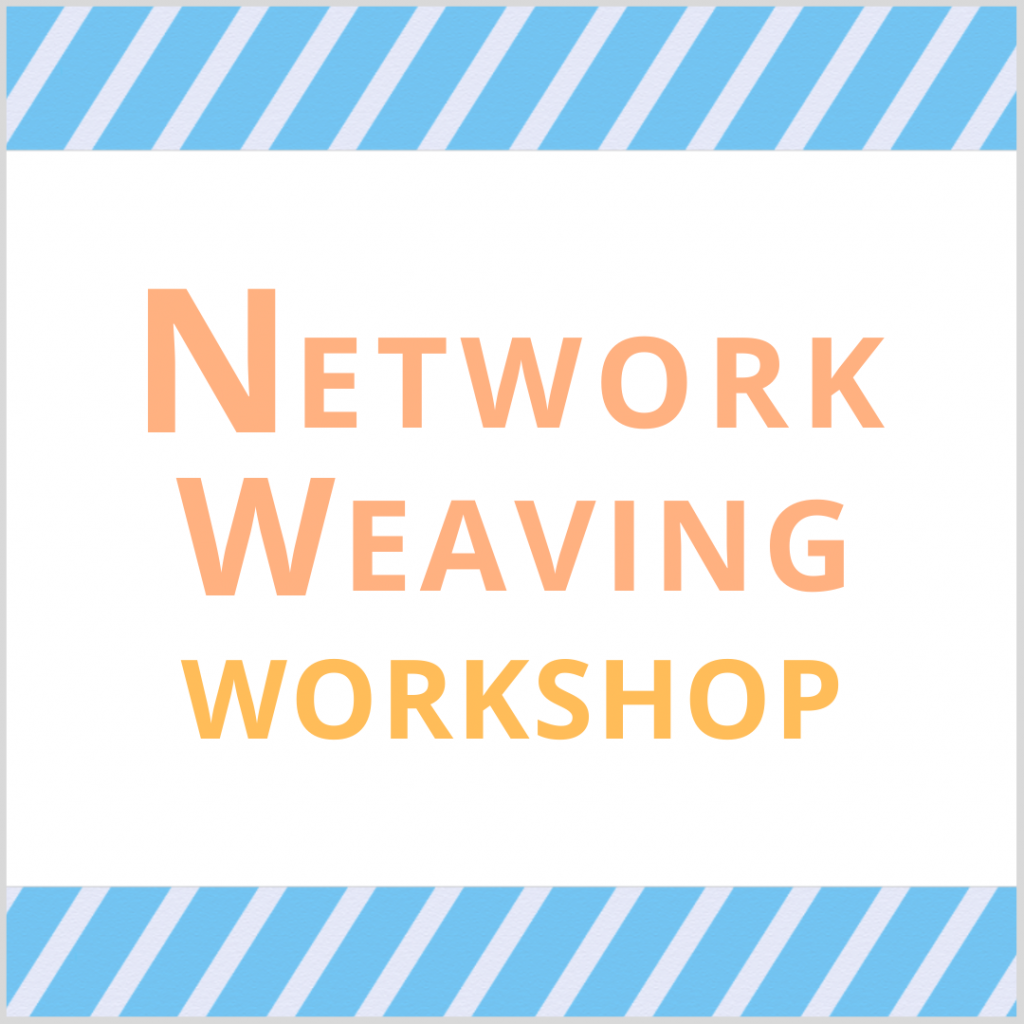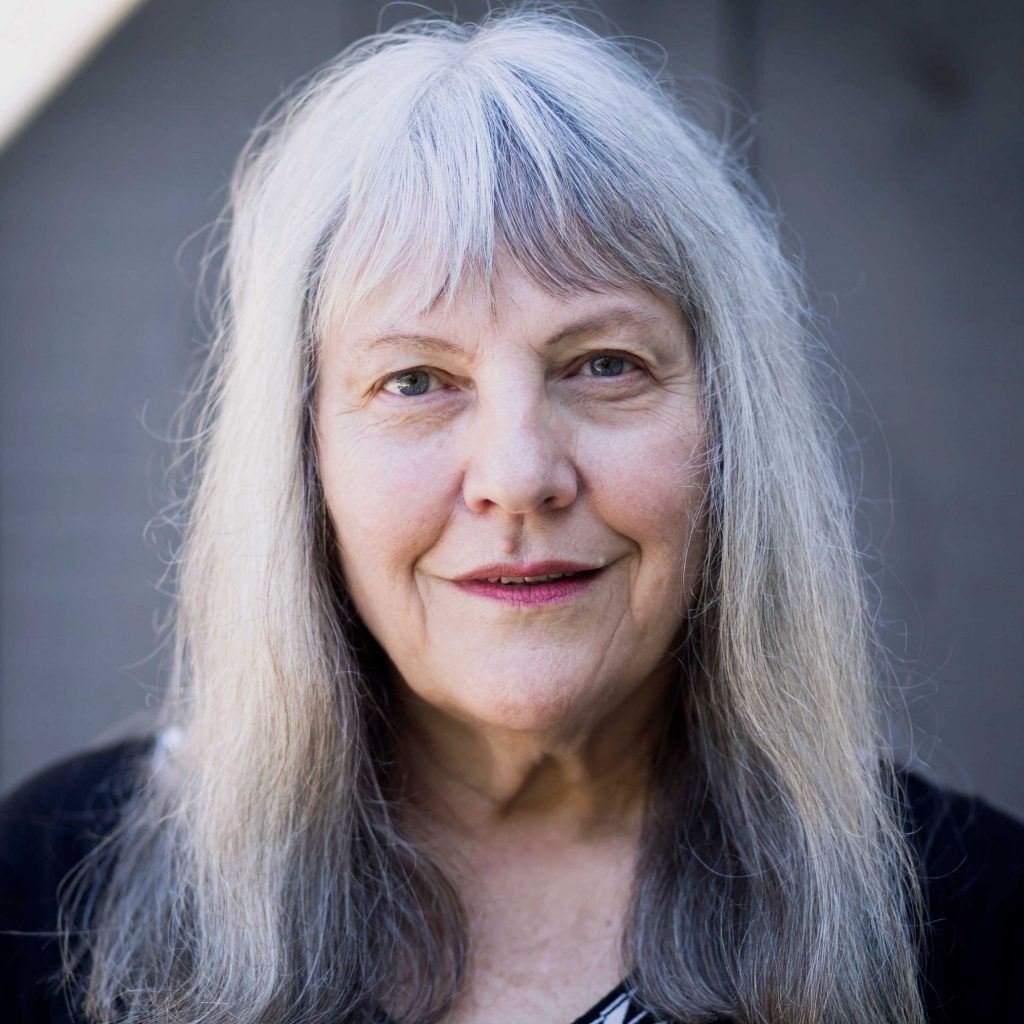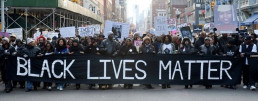The next big horizon? Uniting networks and funders across sectors to transform our world…
We're at a critical moment.
Intersecting crises of people and planet are creating climate disasters, technological disruption, perpetuating inequities, global pandemics. It can feel daunting.
But it can also feel hopeful – when you look at the thousands of networks around the globe working tirelessly every day, preserving biodiversity, transforming education, changing food systems, fostering sustainable tourism, protecting children’s rights, supporting girls activism…
The reality is though, most of these networks remain siloed, reinventing the wheel while not being given the space to learn from each others’ challenges and failures – and struggling to achieve their ambitious visions due to resource and capacity constraints.
In Southern Africa, the word Fito means "joining diverse pieces or people to make one powerful effort".
Networks go by many names – movements, communities of practice, ecosystems, cooperatives, alumni communities. Individually, they reach hundreds or thousands of people through their work.
But when brought together, they can reach millions.
The Fito Network is working to unite some of the most creative and committed practitioners, thinkers, consultants, government leaders, and funders – from dozens of countries across all continents – to learn, co-create, and advocate on the global stage.
We serve as a:
- Matchmaking hub to address common questions, identify synergetic opportunities, nurture emergent ideas, and enhance skills
- Exchange community for filling knowledge gaps, challenging assumptions, trying out cutting-edge practices, and supporting wellbeing
- Ideas incubator facilitating the piloting and sharing out of innovative and equitable technologies, convening formats, and cross-network transformational change strategies (see some of what we’ve already piloted)
- Advocacy platform valorizing networks as indispensable catalysts for social change – through pooling evidence, boosting visibility, and shifting funding structures and paradigms
Imagine if we brought together hundreds of networks working in one sector, all with overlapping goals but slightly different approaches and geographical focus, to explore collaborating for transformational change.

In our work, we’ve come to learn that:
- Complex systems change can only happen through structured and facilitated collaboration. This collaboration almost never happens organically and requires intentional input.
- Collaborative learning ecosystems are critical for improving and sharing change strategies – but to thrive, these need intentional facilitation, accessible knowledge systems, and resources to include diverse stakeholders.
- Networks and movements can be extremely effective mechanisms for rapidly rippling change, provided dedicated processes, leadership, and trusted spaces are in place.
We think convening networks is one of the highest potentials we have to change our societies today – and one of our biggest gaps.
Through combining vast pools of knowledge, resources, and reach across hundreds of movements, cooperatives, and collaborative groups, we can co-design multifaceted solutions, scale success patterns to new communities, directly increase funding opportunities, strengthen leadership skills for collaborative learning and action, and mobilize millions to change habits and policies.
To enable this to happen, though, we need to invest in intentional design, inclusive convening, and guided facilitation.
You’re invited to an experiment

Mosaics are beautiful, intricate collections of diverse pieces that make a collective, beautiful whole. To develop them, you need a shared vision, and careful coordination across many actors. They can take many years to create – but when done, they can touch the hearts and minds of millions across centuries.
Over many years, we have carefully designed a holistic approach with communities like the Bosch Alumni Network and Ignite Philanthropy that brings together networks and funders to engage in deep connection, vast discovery, collaborative experimentation, and collective advocacy.
This “journey” combines field mapping, co-learning, piloting collective solutions, developing collaborative working structures, collating data for collective evidence bases, and working closely with funders to try out new practices and shift approaches.
It looks somewhat like this:
- Connecting & learning (9-12 months): building relationships and trust, deepening peer learning, co-creating purpose and vision, setting up collective structures
- Aligning & piloting (12-18 months): deepening understanding of the system, co-developing change theories, “testing” collaboration through mini-action
- Action & expansion (3-5 years): launch long-term collective projects, expand cycles of learning and sharing, invite and engage broader ecosystem in learning and collaboration.
What could we achieve together?

This model is not unprecedented. In the 1980’s for example, networks and movements came together to combine diverse strategies to move the HIV/AIDS epidemic from a marginalized, ignored disease to a globally-supported collaborative effort.
The possibilities are endless – here is only a small sample of ideas we can envision (and, we’re quite limited in our capacity to do so!):
- 25 million young people engage in collaborative projects piloting new educational methods with teachers and peers
- 30% of European ministries of migration have adopted inclusive, holistic strategies for refugee integration
- Hundreds of communities in Africa and Asia are granted the rights to adopt local biodiversity protection strategies that were shared across networks
- Global campaigns mobilize 100,000’s of small-scale farmers to advocate for shifting food habits and sustainable consumption
Join us!
Come get a taste of what we’re trying at our upcoming “obstacle courses” on climate, food, and education – our final events at the Networks Festival where we will:
- Identify synergies for knowledge sharing and peer support
- Map avenues for larger collaborative work
- Build bridges between practitioners and funders
We are starting with pilots in these sectors, but if you are interested in hosting a networks mosaic or obstacle course in another sector, let us know – email brendon@fito.network!
Getting to the Goods (and Beyond “Folded Arms” Syndrome) in Impact Networks
“Your generosity is more important than your perfection.”
Seth Godin
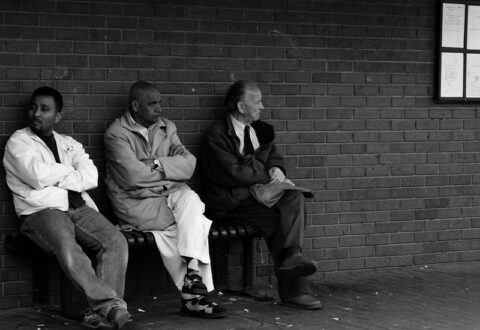
Over the past 20 years of working with a variety of social change networks, I have observed a common dynamic surface after the initial enthusiasm and launch phase. As happened recently with a place-based network about a year into its development (navigating COVID and political uprisings along the way), some members started to bang the “What have we actually done?” drum. Contextual crises notwithstanding, this is not an inappropriate or unhelpful question. As important as relationship and trust-building is, there can come a time when people want to know … “So what?” Sometimes this comes from what we might call more “results-oriented” people in the network. Or it may come from the more time-strapped and stressed, those from smaller organizations, or those who just genuinely don’t see the return on their investment. When this has come up, and people are either holding back (“folded arms”) or threatening to walk, I have witnessed and facilitated several different ways of moving through the real or perceived lack of progress.
- “If you want it, then you better put a ring around it” – In one instance, the convening team of a state-wide network essentially drew a line around all of the network participants and started claiming their successes as network successes. This might sound a bit shady, though it was not done in that spirit. By celebrating “your success as our success,” people felt appreciated and started to turn towards one another and see themselves as a bigger we. They didn’t have to wait to get to mass action. Smaller subsets having success counted.
- Get a quick win – In another state-wide network, fraught at the outset by folded arms despite the fact that people would regularly physically show up for meetings, a network coordinator seized upon a timely policy advocacy opportunity that surfaced, which resulted in a mass outpouring and a legislative win. Nothing sells like success. That early victory got people eager to see what else they might be able to accomplish and they settled in for some more relationship-building.
- Collect and share connection stories – We know that relationship-building is not just about the relationships. It can lead to new partnerships and projects. Often this happens at the start of a network, but is not tracked. We worked with another place-based network that intentionally set out to track the results of connections made in and through the network, and then shared these with the network as a whole. More about connection stories here.
- Highlight the unusual and adjacent conversations – What makes many of the networks we work with unique is that they bring together people who do not often work with each other. Highlighting this and also what emerges out of novel interactions across fields can make “just talking” into exciting explorations and engines of innovation. For a little inspiration on this front, see “Why the most interesting ideas happen at the borders between disciplines” from Steven Johnson at Adjacent Possible (!).
- Pump people up, individually and collectively – Let’s face it, in these times (and really all times), expressing genuine appreciation can go a long way. We work with a network convenor who does this wonderfully, tracking and celebrating people for their individual contributions outside of network gatherings, and constantly speaking to the power and potential of the collective. She just makes people feel good! This can make the proverbial “marathon, not a sprint” more enjoyable.
- Get a super weaver going – Having a really adept and energetic network weaver can make all the difference in the early stages of a network. We have seen the impact this can have when ample capacity is created to regularly check in with people, listen to them, make connections between different needs and offers in the system, and encourage people to share more with one another. When those exchanges start happening, the “there” there is often more apparent.
- Lift up the network champions – Generally there is a small group of people who really appreciate and lean into the value of the network from the get go (gratefully receiving and using resources that are shared, following up with new connections, testing out new ideas, leveraging the network as a platform), making it happen and not waiting for it. Observing this, capturing it, and sharing it with the network can help make the point that the network is what people make of it and give ideas for how to make this happen.
What have you done to successfully navigate impatience and intransigence in impact networks?


About the Author:
Much of Curtis Ogden's work with IISC entails consulting with multi-stakeholder networks to strengthen and transform food public health, education, and economic development systems at local, state, regional, and national levels. He has worked with networks to launch and evolve through various stages of development.
Originally published at Interaction Institute for Social Change

Network Weaver is dedicated to offering free content to all – in support of equity, justice and transformation for all.
We appreciate your support!
donate in the box above or click here
People Stitching Earth | Oppression, Healing, Liberation, and Navigating the Terrain In Between
When we made it back home, back over those curved roads
that wind through the city of peace, we stopped at the
doorway of dusk as it opened to our homelands.
We gave thanks for the story, for all parts of the story
because it was by the light of those challenges we knew
ourselves—
We asked for forgiveness.
We laid down our burdens next to each other.Joy Harjo, “Conflict Resolution for Holy Beings,” An American Sunrise
Origin Story
The first beings were not humans or animals or even plants. The first beings were river, rock, lava, and sky. Later came plants, then animals, then last of all, came two-leggeds who became easily lost and had to learn again and again in order to remember their way. This is a story of that journey—one that started in harmony and abundance and has been transformed by settler colonialism, enslavement, and their aftermath: patriarchy, extractive capitalism, collective violence against aki, the earth, and all her inhabitants. The resulting interlocking systems of oppression choke lungs, poison waters, exterminate life, and obscure the sun.
This is not a story about re-making a fictional ideal past. Harmony, in narrative or music does not preclude disagreement or conflict. This is a story about some of the ways we can return to who we truly are and how we are meant to be in right relation to each other and all beings, mortal and immortal, sentient, interdependent, free.
The Journey
During this time of the great sickness—a time of tyranny, violence and greed—people have been harmed deeply by the practices of oppression: disconnection from source (a higher power and understanding of the world as greater than ourselves such as through spiritual, natural, cultural, ancestral, and/or creative practice); dissociation from our physical bodies; distancing from our emotions; and distortion of our stories.1 Some days the effects are overwhelming; the sickness is life threatening. Some days—with rest and soup, with love and community care—there are moments of shared understanding, connection, and transformational shifts in understanding and behavior.
Beyond rest and community care, what makes these moments possible, and the potential for such moments to multiply exponentially, is not one but many things, things that operate across the dimensions of personal, interpersonal, organizational/institutional, and societal/social systems.2 For those of us working as racial equity change makers—whether as internal or external coaches and consultants, including those who work in intersectional roles as healers, artists, and liberation practitioners—there is a familiar route that embraces organic twists and turns and yields movement in the right direction.
The current emphasis in our field on trainings, assessments, and curriculum—which are all good and necessary components of intersectional racial equity and can be catalytic, if used in their full potentiality—are too often leading people into thorny thickets and near cliff edges where they give up, abandoning the journey, or worse, go back from whence they came. This is not to say that these entry points are not useful ways of understanding our contexts and our own behavior in them, but they are insufficient in supporting the integration and embodiment of new ways of being, understanding, and engaging with the world. When we practice the elements of a liberating ecosystem, we enable the seeds of training and assessments to meet the nutrients and environments needed for them to take root and grow.
There are many ways to traverse the multi-faceted and challenging terrain created by the delusion of white supremacy, but overall the best possible paths are moving in the direction of intersectional racial equity that engages people and systems in practices of healing and liberation. We liken this process to a journey in the woods. There are a number of recognizable clearings or places that support visibility and understanding. And it is in these clearings that clarity, commitment, and learning is possible.
Unlike rational and determinist approaches to intersectional racial equity—ones that center assessment tools, analytical instruments, and pre-defined linear processes—we have found that these pathways are open-ended enough to support opportunities to digest learning and engage in intentional action, through which we can engage in cycles of feedback and reflection to support unlearning white supremacy and re-membering our practices of interdependence, mutuality, and stewardship.
Complexity and Justice-Oriented Change
Advancing racial equity is complex systems change, and while working in complexity there are very, very few, if ever, “best practices”. There are more good practices and most situations require emergent and adaptive practices.
Some characteristics of complexity—as outlined by David Snowden and Mary Boone3—are contexts where:
- “Large numbers of interacting elements are involved.
- The interactions are nonlinear, and minor changes can produce disproportionately major consequences.
- The system is dynamic, the whole is greater than the sum of its parts, and solutions can’t be imposed; rather, they arise from the circumstances. This is frequently referred to as emergence.
- The system has a history, and the past is integrated with the present; the elements evolve with one another and with the environment; and evolution is irreversible.
- Though a complex system may, in retrospect, appear to be ordered and predictable [eg. history], hindsight does not lead to foresight because the external conditions and systems constantly change.
- Unlike in ordered systems (where the system constrains the agents), or chaotic systems (where there are no constraints), in a complex system the agents and the system constrain one another, especially over time. This means that we cannot forecast or predict what will happen.”
This articulation of the characteristics of complex systems is helpful. And too, it is important to recognize that indigenous cosmologies and teachings—particularly those from the Americas and Africa—situate a complex world in which binaries and closed systems do not exist. The cynefin model, the sense-making tool that visually represents Snowden’s complexity theory, is itself from native Welsh principles and language. The word cynefin means roughly “place of our multiple belongings.”
The metaphor of a path or route, one that is organic and emergent, has the flexibility to hold the complex nature of the change we are seeking toward equity and liberation. When traveled with practices of power and leadership sharing, committed attention to innerwork, and embracing multiple ways of knowing, we live in iterations of change that both begin to prefigure the world we want and create the necessary conditions for advancing liberation in the world we are currently living in.
Charting the Terrain
Clearing One – A Reflective Pool
There are many ways to gain an understanding of where an organization and team is in terms of living into intersectional racial equity. Many equity practitioners use written or online assessments. Others hold interviews or focus groups. Some establish storytelling circles or work together to develop murals or other forms of visual narrative. Some use a mix of quantitative and qualitative (including artistic) approaches. Regardless of the approach and the associated tools and practices, the purpose is to get a complex, aggregate picture of what is, a picture of the terrain that is so much more than an organizational map. It is a layering of perspectives that helps the organization and its partners gain some sense of the contexts and conditions comprising the culture and lived experiences of people in the organization or network.

Clearing Two – A Rocky Outcrop
Once a picture of the terrain is made visible, another clearing presents itself. This rocky outcrop is a place where everyone is able to see the full and discrete snapshots of the organization and participate in a shared meaning-making process about what these snapshots might say about the team and the organization. However, collective sense-making requires some shared understanding of the current and historical structures, strategies, and belief systems that benefit some people at the expense of others. This is a juncture in the journey where indepth, whole-system conversations are crucial to restore the very real stories of settler colonialism, enslavement, genocide, wage theft, and extractive capitalism that have largely been disappeared from and or greatly distorted in our education systems. Building on these understandings, teams can also develop a shared understanding of how the continuing impacts of these legacies and other ongoing systems of oppression and inequity interact to perpetuate the manifestations of inequity in our lives and organizations. This discordant recognition is fundamental to the path.
Disagreements about what it all means and why—this generative tension—is what pushes teams and organizations toward deeper understanding. How is it that our shared language is so full of references to militaristic strategies that supported western expansion, manifest destiny and Native genocide? And how is it that the end of the enslavement of African and then African American people has done little to shift the fundamental economic, health, educational—insert just about anything here—disparities between whites and Blacks? The actual questions that teams grapple with have a lot to do with who’s on the team, their lived, racialized experiences, and the depth of their power analysis.
What matters is that teams are moving towards a shared understanding that interrupting current, intersectional racial inequities isn’t possible without having a depth of knowledge about historical inequities and the practices and systems that support their perpetuation. In this rocky outcrop, teams will often read, attend workshops and trainings, participate in caucus or affinity groups to support interrupting internalized oppression and internalized privilege. This learning journey is essential and what it entails depends on who is on the journey together. Among people of similar racialized identities it may mean grappling with global colonialism and the ways that it has impacted different peoples and different families’ histories. Healing often becomes a central focus, calling in ritual and ceremony to support the processing and release of past and present trauma.
This can be a difficult time in an organization. The fallacies that held the team together have been stripped away. But nothing new is yet in its place. It is a time for care and humility. It is a time to support the ingestion and digestion of the pervasive, corrosive presence of racial equity, making space for the restoration of our collective humanity within and across all racialized groups. It is a time for reconnecting to source, reengaging our bodies, reclaiming our emotions, and reweaving the fullness of our stories. This can mean a necessary, intentional, and sometimes scary unmooring in the day-to-day. And too, it is an opportunity for people to show up differently and build the muscle and heart necessary to get to the next evolution in the process. It requires cultivation of courage, humility, and room for risk-taking, as well as tools supporting accountability and collective tending to harm. This place demands space and time. This place requires more of us than we have sometimes been able to give. There is a necessary clarity that comes from such disruptions. As Norma Wong says, “transformation requires agency.” Some people may, in fact, choose not to move with their team or organization. And that is part of the journey too.
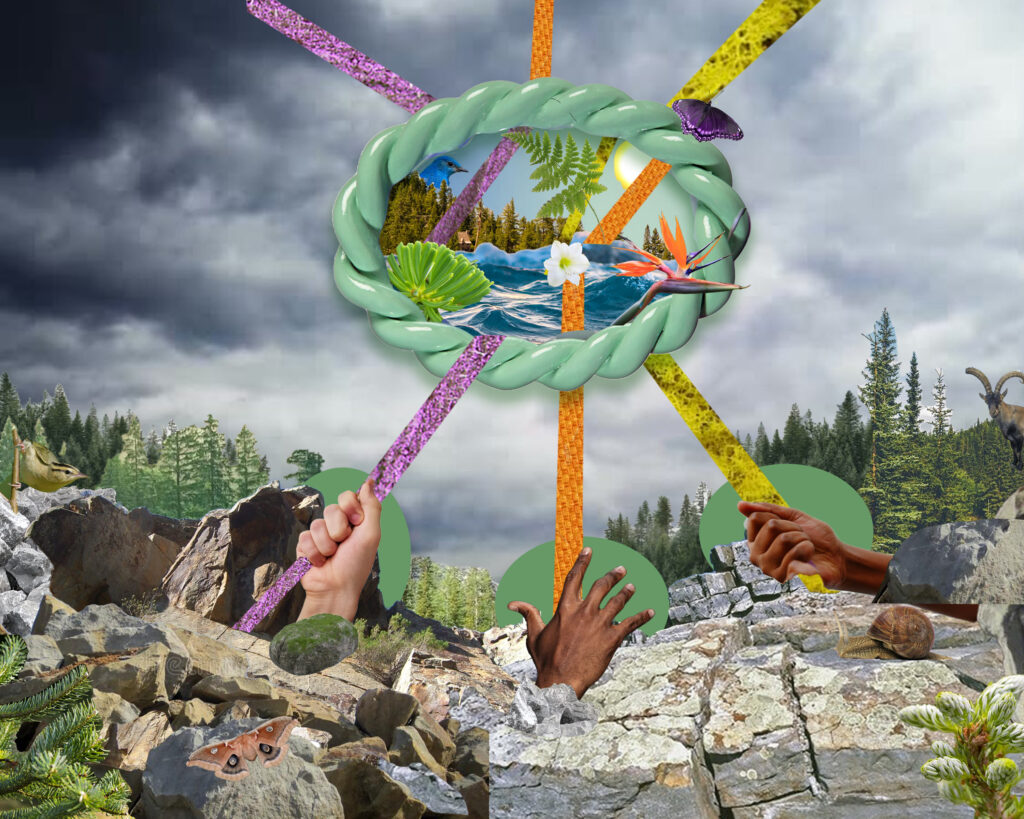
Clearing Three – A Sudden Vista
Through a commitment to authenticity and rigor—and doing the necessary work of deepening our understandings of historical and current conditions that affect our individual and collective experiences—we come to a sudden vista, an opening in our capacity to see a different future. A future where we all have the ability to thrive.
It is here that a visioning process can truly expand our shared picture of a liberated and liberatory future. From this vision, we can outline the values and principles that guide how we be with each other in liberating ways and define some key short term and long term transformation efforts, arriving together at those aspects of the organization that, if transformed, would enable people to experience an actual taste of equity in the immediate term while working on efforts to change the organization overall in the long term.
What we are creating is not new, yet it can be wholly unfamiliar. However, we have everything we need to make this visionary future possible. It simply requires courage, imagination, and the willingness to move as if we have one foot firmly on land and the other submerged in the tumultuous and profuse waters of the sea.4

Clearing Four – A River Flows
Once the vision, values, hopes, and dreams, the team can start developing some focused priorities and goals and the implementation effort begins to flow. But equity transformations are always a mix of inspirational visions and more tangible decisions and practices. Weaving across the two is the art of advancing complex systems change in which we are developing experiments across the organization’s functions and programs. Or it might be one or two short and long term efforts from which the team and organization is continuing to learn and to refine in ongoing cycles of reflection and growth. What matters is that the effort is continuous and fluid, and that the fluidity takes into account boulders, logs, beavers, otters as obstructions are also natural innovations to the existing ecosystems. Throughout this process, the team is meeting current capacity and emerging circumstances in ways in which both the vision of equity and the realization of equity are contiguous tributaries in the river’s powerful flow.
Context Affects the Terrain
While we are all swimming in the torrential waters of racial inequity and other intersectional forms of oppression, we are affected differently. Some are buoyed by floatation devices. Some are carried along by speedboats. Others are fighting to keep their airways above the surface of the water. The same is true for leaders, teams, organizations, and networks.
To make sense of these differing contexts—at all of the levels of racial oppression including internalized, interpersonal, institutional and systemic—we are going to describe differing approaches based on where different types of individuals, teams, organizations and networks live along a white dominant-to-liberatory spectrum: 1) White Supremacy Culture, 2) Multicultural Stance, and 3) Pro Black and Indigenous.
While such classification efforts are inherently overly simplistic, there is sufficient value in outlining different approaches based on these categories, contexts and associated conditions.
1) White Supremacy Culture (aka “The Delusion of White Supremacy & the Culture that Upholds It”)
In an organizational culture of white supremacy, organizations are habituated to working in ways that uphold the delusion of white supremacy whether intentionally or not. These cultural practices have been laid out in the work of Tema Okun and continue to be deepened by other racial equity practitioners. Initially identified as thirteen habits, the framework has evolved to include nuanced descriptions of behaviors that reify inequity, transactional relationships, and oppressive power structures. These cultural habits are exemplified by valuing perfectionism, individualism, fear, right to comfort, competition, urgency—and drive most organizational decisions and overall organizational culture in white dominant organizations.
These organizations are most often:
- White led and/or have a history of white leadership and predominately white staff (not always white-led; may include people of multiple races at various levels of the system but not in large numbers in leadership and if so, not for very long);
- Equity focus is on diversity, equity & inclusion (DEI), with an emphasis on diversity; and
- People exhibit and experience disconnection from source (a higher power and understanding of the world as greater than ourselves such as through spiritual, natural, cultural, ancestral, and/or creative practice); dissociation from their bodies; distancing from their emotions; and distortion of their stories.5
- There are also historically people of color-led organizations that operate predominantly in this fashion; most often they are in areas of work that are deeply steeped in white supremacy culture such as some legal, policy, research, philanthropic and merit-based youth-serving organizations.
Deep equity work in this context focuses on making visible the ways in which white supremacist ways of being and doing are operating as an uninterrogated norm which serves to reify white leadership and the myth of white supremacy and/or undermine the wisdom, gifts, and value of BIPOC people. Organizations in this category are often set up to support the learning, comfort, safety, and power of those in leadership and particularly white leaders. Change processes can unintentionally replicate these patterns at the expense of native people and people of color.
Racial equity change makers will often focus on cultivating equity-based awareness and understanding with white leaders in the system to ready them and thus the organization for deeper equity work. This aspect of the change effort can be very depleting for staff of color in every level of positional power as well as for all staff with less positional power within the system. The tax of this effort is in direct relationship to white leaders willingness, courage and capacity to develop a baseline understanding of structural racism and intersectional elements of oppression. If leaders are resistant to deepening their awareness and/or actively suppressed learning then little progress can be made without developing alternate leadership structures to support the organization in its evolution.
2) Multicultural Stance
In multiracial/multicultural contexts, organizations tend to exhibit characteristics of both white supremacy culture and what Okun would call “antidotes.” In this instance, an organization might be more recently led by people of color and/or have significant numbers of people of color throughout the organization including on the leadership team. In this context, the racial equity and liberation (REAL) work is more often focused on equity, which is made possible by the fact that people in the organization have a solid understanding of structural racism and intersectional elements of oppression.
The organizations are often actively seeking to disrupt the habits of white supremacy culture and people have more shared practice of expressing the harm caused both within and beyond the organization. However, having not yet fully developed the muscles of an equity-based organizational culture, the organization and its leaders will often default to white supremacist ways of working in urgency or in high-stakes decision-making, for example relying on positional power instead of embracing wisdom, experience, and skill-sets from multiple people in the system and therefore have trouble implementing equity-based systems change internally.
While all racial equity work needs to center healing, the work in multiracial/multicultural contexts often necessitates a focus on healing at intra-personal, interpersonal, and organizational levels simultaneously in order to create the needed conditions for equity-based systems change. REAL change in this context is about unlearning our beliefs and related actions as a result of internalized oppression and our complicity with white supremacy as people of color. For white people in all contexts, the work is about interrogating internalized white supremacy so that long standing ways of maintaining privilege are dislodged, making space for new ways of living and being that don’t center whiteness and the power it exerts in explicit and implicit ways. Specifically, in multiracial/multicultural contexts, white people tend to have more systems based understanding but are often still struggling to recognize that impact is not exclusively the result of individual intention. The arc of learning in this context is to develop a more complex understanding of the relationship between “it’s all my fault” and “it’s all the systems fault” in order to recognize that—because of race, power and privilege—they are both simultaneously true. In order to live into this complexity, it calls on all of us to begin to embody new ways of being.
3) Pro Black and Indigenous
In contexts where Black and Indigenous people, wisdom, and cultures are centered, organizations are led and predominately composed of multi-identitied or single-race identified Black, Indigenous and people of color (BIPOC) that have done work to address anti-blackness and anti-indigenity as a collective. The organizational vision and mission are rooted in social justice and liberation. People exhibit greater connection to source. They are in touch with the wisdom of their bodies and their emotions and are resourced by and able to be in whole and simultaneous stories. The focus of the work is beyond equity toward liberation and sovereignty.
In this context, healing work (individual and collective) is both foundational and ongoing as the organizational culture exists in a wider, toxic, and systemically oppressive society. In addition to engaging in healing and liberating practices, liberation requires continuing to address inequities; building our collective muscles for engaging in generative conflict, giving and receiving feedback, and holding each other in loving accountability; in addition to developing and evolving more equitable power structures and practices. It takes collective care and courage to embody and enact the systems, structures, ways of being that emulate the world we want.
There is great potency in this context as it creates the ability to experience some of the new world that we want while still living in the hollowed shell of a decaying, oppressive society. And too, the dissonance between two worlds requires rigorous attention and care on the part of the team as well as humor and love. It is here that we begin to crack open the old and spill toward the new.
“When I dare to be powerful to use my strength in the service of my vision then it becomes less and less important whether I am afraid.”
Audre Lorde
Approaches and Practices
So much of the focus of racial equity-based system change is on tools and frameworks. This tendency reflects the white dominant habit of overvaluing numerical data and the written word. While surveys, assessments, numerical analysis and the frameworks that outline how to apply them are valuable, they will not, in and of themselves, lead to intersectional racial equity let alone liberation. What will lead to equity is changing both what we do and how we be together. Assessing where an organization in terms of racial equity is the first tiny step and can be harmful if other steps don’t follow.
The Elements of Transformation
We have found that the most essential approaches to advancing intersectional race-equity systems change are those rooted in the elements of transformation toward liberation acting as the five fingers of one hand:
- Deep Equity & Liberation
- Complex Systems Change
- Leadership & Power Sharing
- Innerwork
- Multiple Ways of Knowing
What we are up to in our justice work boils down to equity and liberation whether we are talking about environmental justice, gender justice, educational access, or any of the social and economic harms resulting from the legacies of slavery and colonialism in the U.S. Advancing this kind of change IS complex systems change. In order to lead complex systems change, we must expand our understanding and expressions of leadership to embrace power-sharing and collaborative action. Leading together in this way requires innerwork, so we can be present for and resilient with change, and expanding how we know and what is considered wisdom in order to dislodge the dominance of white, western culture. This is individual and collective work. We have written extensively about this. For a deep dive, please read our blog on Practicing the Elements of a Liberating Ecosystem and earlier articles published in the Nonprofit Quarterly (NPQ): Pursuing Deep Equity, Cultivating Leaderful Ecosystems, Embedding Multiple Ways of Knowing, Influencing Complex Systems Change, and Centering Inner Work.
Equity-Focused Teams
In organizations and networks, particularly majority white and/or white dominant culture and multiracial/multicultural ones, any equity focused effort needs to be supported by an internal equity team—one that draws on the organizational diversity in terms of roles, experiences, expertise and identities. In order to advance equity, there needs to be an aligned and skilled group to shepherd change that has the credibility to champion emerging changes. Some of the qualities of equity team include:
- people committed to equity;
- people who have some lived experience of the effects of intersectional and systemic racism;
- people committed to the mission and vision of the organization;
- people who have either have the decision-making power and/or influence ability to advance change;
- people willing and able to commit to the time and effort equity efforts will require (note: the organization needs to be sure to make this focus and attention possible, e.g. this can not be an additional item added to people’s work expectations without removing other things);
- people able to hold confidentiality (share learning not other people’s information) and
- people able to engage in difficult conversations and see the potency of generative conflict
In contexts where Black and Indigenous people, wisdom, cultures are centered and organizations are rooted in a liberatory stance, the commitment to and experience with advancing racial equity exist across the organization and power is shared more broadly. In this context an equity team may or may not be necessary. Rather equity transformation efforts can be held in existing structures and team compositions. Racial equity coaching and consulting support in this context is even less about the doing and more about the being, tending to the complexities of transformational change in interracial teams and organizations while existing in a violent, toxic, and oppressive society.
Internal Skill Development
In all contexts, advancing intersectional racial equity requires that we develop and/or deepen our skills in being deeply present, loving, and human with one another. It means we need to lift one another out of survival states—where all energy is necessarily focused on getting our basic needs met—and cultivate the ability to be present to past and current suffering, giving voice to what has been unspeakable, entering conversations from a place of deep curiosity, and being willing to engage with difference—different perspectives, experiences, ways of making sense of the world. We do this because the change we seek actually requires all of us. It will not happen because of a few exceptional leaders. American exceptionalism is actually part of the knot that binds us in deeply inequitable ways.
Depending on their context, as outlined in the earlier section, and the existing experiences and expertise of different teams, new skills and/or muscles (as the nascent skill may actually exist it is just underutilized) will need to be developed. That said, there are some foundational skills and/or muscles needed to advance racial equity and the interdependent elements of a liberating ecosystem. They are:
- the ability to engage in generative conflict—actually embracing difference and the ways it can lead to conflict as a source of creativity and change;
- providing real-time affirmative and critical feedback on how we are impacting one another so that we can learn and grow;
- recognizing that organizations, leaders, teams and networks need supportive structures and practices to survive in all times and most certainly to thrive during equity change efforts so be sure to get your foundation set before building something new; and
- holding loving accountability with one another – “the practice of loving accountability consists of honest and authentic communication, vulnerability, and the willingness to hold each other accountable for our impacts—beyond just words. If a collective value or guiding principle is repeatedly violated by someone, and no amount of communication and support can interrupt it, then loving accountability instructs us in employing meaningful consequences—not as punishment but rather as ensuring the health of the collective through meaningful boundaries.”6
Depth of Engagement
Any authentic, intentional and focused effort to advance intersectional racial equity has the potential to lead to transformational change. Such change could be evidenced by significantly increased understanding of systemic racism and the ways internalized supremacy is playing out in a white leader’s priorities and decision-making. Transformational change could look like a BIPOC team’s success in deepening its generative conflict muscles and being able to really unpack unspoken assumptions and internalized oppression in order to create new ways of advancing its vision and mission that supports the team in being and acting from liberation.
There is no “right approach” to support equity-based systems change. Rather there are necessary nutrients to ensure such an effort will seed, root and flourish. These nutrients are similar whether we are providing one on one coaching, team facilitation and support, or an organization-wide equity change effort. While all plants require differing amounts of sun, water, warmth, all require the fundamental macronutrients of carbon, hydrogen, nitrogen, oxygen, phosphorus, and potassium.
- Clear sense of purpose of and strong commitment to equity effort and its alignment with vision, mission and strategies;
- Willingness to let go of existing practices, structures and approaches and experiment with new ways of being and doing in order to change, learn and grow;
- A recognition that the wound of intersectional racism is still festering and any effort to heal and transform it brings with it the possibility of new injuries, discomfort, alternating periods of remission and acute illness and requires an enduring commitment to stay the course.
As individuals and teams evolve their application and wisdom of intersectional race equity and liberation, there are some frequent markers of understanding that mark this transformation. We draw these from some of the components of Jay McTighe’s and Grant Wiggins’ Understanding by Design framework.7
Perspective
Regardless of the context they are in, individuals and teams are able to articulate and apply the importance of race equity work in their day to day intentions, priorities, and decision making.
Empathy
In all contexts, individuals and teams are deepening their capacity to listen and see and feel things from different points of view and honor the lived experiences and perspectives of one another all while moving toward equity and liberation.
Self and Group Knowledge
People demonstrate a recognition and ability to grapple with their biases, triggers, and self perceptions in order to deepen their own and the team’s capacity for equity-based systems change.
These markers reflect some of those outlined in the modes of the Liberatory Design8 cycle, although those modes are stages of a process and what is being outlined here are markers of understanding, how you might know things are shifting in meaningful ways. Nonetheless, Liberatory Design provides an integrative approach—weaving across design thinking, complex systems change, and racial equity— and serves as another way of thinking about cognitive and behavioral approaches to change rooted in experimentation.
Moving through an Unfamiliar Present Makes Possible an Equitable and Liberatory Future
To live as if. It is not easy. Inner work and our cultivation of the capacity to be present, to see what is, to be part of the rapid, long and slow process of evolution, revolution, to breathe through it all is so necessary. Throughout this work we will dance and sometimes stumble and fall. Our cores must be both strong and flexible; and it takes all of us to reach our appendages toward each other, to lift one another up.
The world depends on us. Race equity and liberation (REAL) work gets us closer to holding each other in a field of love, from which place so many of the ills of the world are healed. As Paula Gunn Allen writes in Grandmother’s of the Light:
“It is said at the time of the beginning, the Goddess will return in the fullness of her being. It is said that the Mother of All and Everything, the Grandmother of the Sun and the Dawn, will return to her children and with her will come harmony, peace and the healing of the world. It is said the time is coming. Soon.”
We are here to turn the wheel toward a new beginning. One in which all of her children are free.
Collage credit: Naima Yael Tokunow
Originally published at Change Elemental
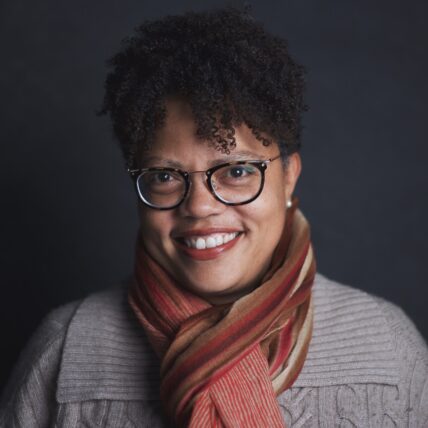
Elissa Sloan Perry (any pronouns used with respect) is of African and Mississippi Choctaw descent, hails from Missouri, and is a 30-year resident of California. She supports people with a vision for an interdependently thriving people and planet to be better in what they do. Elissa joined Change Elemental in 2013 as the Program Catalyst for the Network Leadership Innovation Lab, became CoDirector in 2015, and transitioned to the Leadership Hub in 2021.
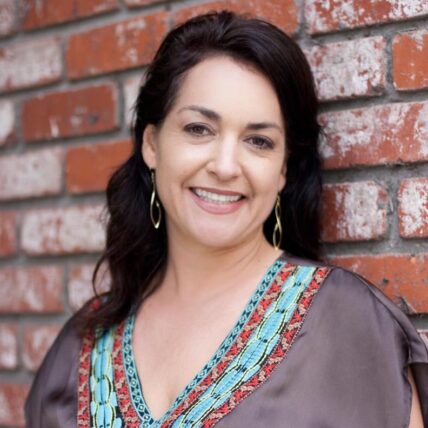
Aja Couchois Duncan (she/her/we) is a San Francisco Bay Area-based leadership coach, organizational capacity builder, and learning and strategy consultant of Ojibwe, French, and Scottish descent. A Senior Consultant with Change Elemental, Aja has worked for 20 years in the areas of leadership, equity, and learning.
1 This framework for understanding the ways oppression separates us comes from the profound and inspiring work of Monica Dennis.
2From the work of Camara Phyllis Jones, “The American Journal of Public Health,” Levels of Racism: A Theoretic Framework and a Gardener’s Tale 90, no. 8 (August 2000): pp. 1212-1215, https://doi.org/10.2105/ajph.35.12.1319, and john a. powell, “Structural Racism: Building on the Insights of John Calmore,” North Carolina Law Review 86 (2007): pp. 791-816.j
3David J. Snowden and Mary E. Boone, “A Leader’s Framework for Decision Making,” Harvard Business Review, November 2007, pp. 1-9, https://doi.org/https://www.systemswisdom.com/sites/default/files/Snowdon-and-Boone-A-Leader’s-Framework-for-Decision-Making_0.pdf.
4“one foot in the water / one foot in the sand is where I hear the best.” Alexis Pauline Gumbs, Undrowned: Black Feminist Lessons from Marine Mammals (Chico, CA: AK Press, 2020).
5 This framework for understanding the ways oppression separates us comes from the profound and inspiring work of Monica Dennis.
6Aja Couchois Duncan and Kad Smith, “The Liberatory World We Want to Create: Loving Accountability and the Limitations of Cancel Culture,” NonProfit Quarterly, May 19, 2022, https://doi.org/https://nonprofitquarterly.org/the-liberatory-world-we-want-to-create-loving-accountability-and-the-limitations-of-cancel-culture/?utm_content=208660872&utm_medium=social&utm_source=linkedin&hss_channel=lcp-542508.
7David J. Snowden and Mary E. Boone, “A Leader’s Framework for Decision Making,” Harvard Business Review, November 2007, pp. 1-9, https://doi.org/https://www.systemswisdom.com/sites/default/files/Snowdon-and-Boone-A-Leader’s-Framework-for-Decision-Making_0.pdf.
8“Introduction to Liberatory Design,” National Equity Project, https://www.nationalequityproject.org/frameworks/liberatory-design.

Network Weaver is dedicated to offering free content to all – in support of equity, justice and transformation for all.
We appreciate your support!
donate in the box above or click here
ENACT! – a new month-long festival on networks for social change
Click on the images below to learn more about each group of events:

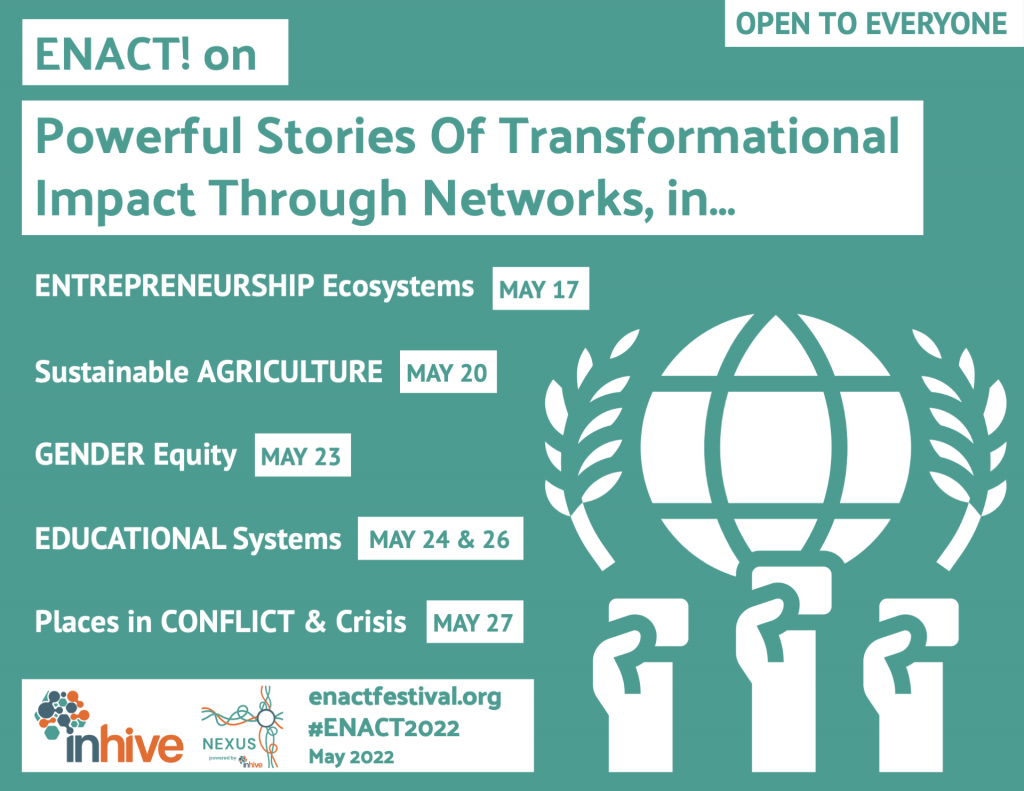
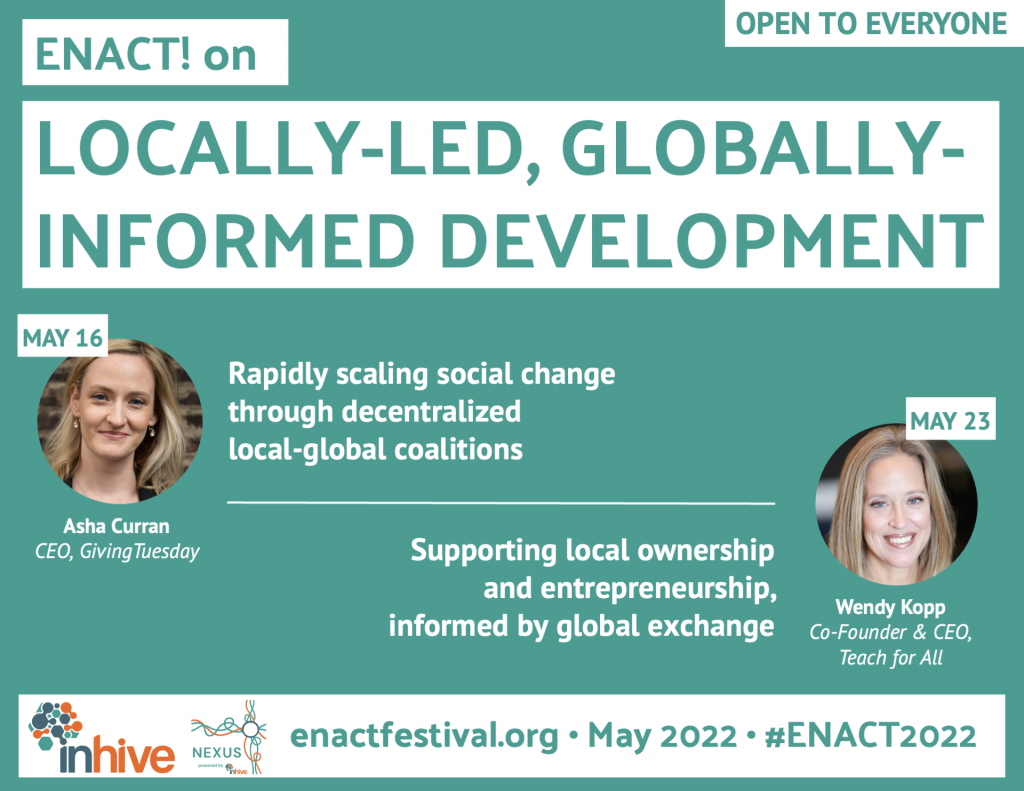
Building Our Network Mapping Muscles
On Wednesday March 16th Katy Mamen and Paul van der Cingel held a webinar on “Building Our Network Mapping Muscles.” For those of you who weren’t able to attend the session, we are making the video available as part of the resource packet on network mapping. This resource packet also includes a more detailed slide deck than the one shown in the video.
Many other mapping resources were mentioned in the chat.
- Many people use kumu.io to visualize their mapping data. There are tutorials on their site and Christine Capra (Greater than the sum) can help.
- NodeXL has a focus on using twitter and Facebook data as a way to surface relationships in larger groups.
- SumApp is the survey platform that many people use to gather mapping data from network participants. See https://greaterthanthesum.com/
- There is a community of practice for network mappers. You can sign up here
- June Holley shared a set of sample questions you can use in a survey Christine Capra added, “A pair of questions that's been really useful in some networks I've worked with are 'what are the opportunities you're seeing?' and 'what challenges are you facing?'”
- There are 6 additional mapping resources here.
You can contact presenters at katy at sonic.net, p.van.der.cingel at windesheim.nl and christine.capra at gmail.com
Download the full resource - including the slide deck and PDF with link to webinar, HERE. OR Access the webinar directly, HERE.
Announcing Kinship: a new initiative
Hello to my network weaver peers! Over the last 10 years, I’ve been exploring how to use networked approaches to align the work of many organizations to change systems. Through New Directions Collaborative, Nancy Gabriel and I and some colleagues in this network have worked with initiatives working on food systems, community development, climate action, and more. We learned a lot about how to create successful collaboration, especially refining how to facilitate work with a focus on outcomes, equity, and on building trusting relationships every step of the way. I hope you will find these blogs sharing our experiences and this Resource page useful.
I’m now focused on creating a new initiative called Kinship: A Hub for Amplifying the Power of Community to practice and deepen our skills in how to create a community that can heal, collaborate, learn, and care for the whole.
Remember to imagine and craft the worlds you cannot live without,
just as you dismantle the ones you cannot live within. – Ruha Benjamin
In the spirit of looking for what is missing and growing what is healthy, my vision is to host regular spaces in my community of Seacoast New Hampshire where experienced community builders and social change leaders can connect with peers, get coaching, and learn together. I’m curious to see how hosting and weaving a place-based community over time can root and grow a culture of solidarity, healing, and co-creation. My hope is that people take what they experience in Kinship spaces back into their homes, workplaces, and communities.
As our families and communities face unprecedented changes, we need to move from go-it-alone individualism to create resource-rich environments of care, peer support, and resonance. I see a need for ongoing community-connecting spaces to fortify us so we can respond to change with creativity, care, and courage. Deep bonds of kinship with each other and nature is also a resource for burnout, mental health challenges, and healing trauma and oppression.
Please check out the new Kinship web site and if you'd like to join our newsletter, enter your name at the bottom of the home page or like this Facebook page. I will host small groups and facilitate workshops in person in Seacoast NH and will be producing a podcast (stay tuned.) I’m offering on-line trainings as well, including these in April:
Listening that Enables New Possibilities
Storytelling that Grows Connection and Learning.
I’ll be keeping New Directions Collaborative as my business entity. Nancy and I have revised the service offerings to focus on training, meeting design and serving as thinking partner/coaches. We will be shifting out of on-site facilitation and cross-sector systems change work and will look to give referrals other consultants who do this work.
I look forward to sharing back with this community how Kinship evolves and what we create and learn. Perhaps down the road, what grows here can generate seeds that we can share with others to bring into their communities.
Bridge the Gap between Vision and Reality: a webinar offering
It’s a joy when self-organization works well. It’s a drag when it doesn’t. The gap between how it can be - or should be - and what it is can sometimes be too big. That’s especially true when individual team members lack flexibility and self-reflection, when decision making by the team is driven by hidden power games and not-so-hidden rigid and defensive behaviour, and when there is a lack of openness. These create frustration, distance, demotivation, powerlessness, and other symptoms indicating that collaboration is not as effective and joyful as it can be. It reduces the quality of work.
Experts show you a piece of the puzzle of what self-organization can be like. Most of them offer an inspiring glimpse of what is possible. But when the gap between their vision and your day-to-day reality is too big, you might get frustrated. You may even doubt your capability to make self-organization work well within your team or organization. Vision without a direction is like hearing someone speak about Paradise, without showing you how to get there and providing tools to accelerate your journey. So, how do you get there?
- Declaration of Responsibility
The first step you all take is to sign the declaration of responsibility. You declare that you are willing to take full responsibility for yourself, the team (the collaboration), and the quality of the service or product that your organization provides. You never relinquish that responsibility.
- Responsibility for yourself
To take full responsibility for yourself, you need self-awareness. You need to know who you are and what drives you, the purpose in your life, and you need a healthy mind-body balance to convert the signals your senses give you into actions that allow you to take good care of yourself and others.
- Responsibility for your team (collaboration)
To take full responsibility for your team, you need insight into the invisible forces that influence everything you do. Compare it to the operating system of your computer or tablet. If that doesn't work, no software will work well, and you won't achieve the desired outcome. The Periodic Table of Radical Respinsibility is a learning tool to help you build a solid operating system.
- Responsibility for the output
To take full responsibility for the quality of what you as a team deliver, you need an instrument to 'measure' the level of trust in your team or organization. After all, trust determines what you can achieve. A profound tool for measuring the state of trust in four dimensions is the Power of Connection model (image). You can use it both as a reflection and feedback tool.
For over 30 years, Norbert Netten, founder of The Power of Connection method, has worked with teams to provide insights and tools they need to strengthen their collaboration. Norbert is a strong advocate for self-organization. When it works well, it supports people to take responsibility for themselves, the team, and the quality of their work, without compromising on any of those factors, which is what usually happens.
Webinar series
Norbert Netten, founder of the Power of Connection, is organizing a webinar series on how to bridge the gap between vision and reality. In five webinars, starting April 6th, you will explore the Declaration of Responsibility and Transactional Analysis. You will also learn to use the Periodic Table of Radical Responsibility learning tool and the Power of Connection model reflection tool to bridge the gap between vision and reality. This is a great opportunity to reflect on the quality of collaboration within your team or organization. And when you do recognize a gap, you can immediately start closing it and use your power to reach your goals.

Full details and subscription HERE
The code for 15% discount for Network Weaver subscribers: NWSS22-1 (Capitals!)
* This webinar announcement is published as an extension of Network Weaver's Community Space. We offer space for sharing on this platform, and invite you to use information shared here as it serves you.
Seeing the World Through a Network Lens
June Holley offers Network Weaving Workshop, another training slide deck for use in your organization or network. It provides an introduction to many network concepts and includes a number of activities such as speed networking, mapping your network, and the Network Weaver Checklist.
This slide deck is particularly good for sets of organizations who are not well connected. As result of this session, they would be starting to see the world through a network lens.
The slides are offered in pdf format, but we are also sharing a link to the google slides. Create a copy of the presentation and save it as a new name in your google drive. This way, you can modify them to adapt the presentation to the particular group you are working with.
Access the Network Weaving Workshop slide deck HERE.
June Holley has been weaving networks, helping others weave networks and writing about networks for over 40 years. She is currently increasing her capacity to capture learning and innovations from the field and sharing what she discovers through blog posts, occasional virtual sessions and a forthcoming book.
featured image found HERE
Converge Announces New Opportunities to Learn about Impact Networks
Attention Network Weavers: Are you eager to learn more about forming, leading, or revitalizing networks for learning and action?
Converge is pleased to announce open registration for three learning opportunities:
- Introduction to Impact Networks, a 45-minute webinar: Dec. 2 or Jan. 17
- Network Essentials, an interactive 3-hour workshop: Dec. 10 or Jan. 14
- and Network Leadership Series (NLS), a network practice cohort which includes 8 sessions over 2 months starting November 30.
Details and registration for all offerings can be found on at converge.net/trainings.
Since learning is best with peers, we encourage you to bring two or more people from your network or organization – and we offer a discount for registering more than one participant. Discounts and scholarships are available for those who want to participate but money is an issue.
What are these trainings about? Impact networks bring diverse stakeholders together for collaborative learning and action to advance a shared purpose. Converge believes in the power of networks to create systemic change in a world of complexity and continual change. We seek to advance the field by supporting and connecting those who lead and coordinate impact networks.
Our trainings are based on a co-learning approach. We’re committed to:
- Meeting people where they are, recognizing that network leadership involves ongoing deepening of self-awareness and systems awareness.
- Making learning actionable, sharing concepts with interactive opportunities for participants to apply them to their real-world challenges.
- Sharing practical tools that have evolved through Converge’s collaborations with a variety of networks across the globe.
- Drawing on everyone's wisdom, creativity, curiosity, and generosity.
- Embracing diverse learning styles and ways of knowing that integrate thinking, feeling, and doing.
If our approach resonates with you, we hope to see you at a future training!
About Converge: We are a network of practitioners who cultivate impact networks. We are systems strategists, designers, facilitators, educators, and evaluators committed to co-creating positive impact by advancing the network approach to collaboration. Learn more at converge.net.
CULTURAL RACISM – A PERSONAL EXPERIENCE
Dr. Froswa’ Booker-Drew is a Partnership Broker. Relational Leadership Junkie. Connector. Author/Speaker/Trainer. She graciously gave permission to Network Weaver to publish her recent facebook post (below) in response to the murder of George Floyd and the issue of police brutality – offering her personal experience with cultural racism and advice for white friends on how to show up in solidarity responsibly.
I’ve been silent for a reason. I needed some time to process my anger and pain. Those who are close to me know that I’ve been dealing with a daughter who feels helpless. She sent me a text a few days ago that she couldn’t stop crying. I’ve been processing this with my 72 year old mother who has had a lifetime of this insanity. She told me about the time she witnessed a Black man being beaten by the police as a young woman. She’s seen years of this and remarked that in her lifetime that with all the technological advances, racism and oppression haven’t changed. She said the only thing that has changed is the fact that cameras exist to prove it.
I’ll share my personal experience: In February, I was driving back from visiting my daughter in college and I jumped in front of a state trooper. I wasn’t speeding, just trying to get home. I was pulled over and I couldn’t understand why. He said I didn’t have a front license plate. I informed him it was a rental car I was returning the next day. He then accused me of drinking because he smelled alcohol in my car. I reached down to pick up the hand sanitizer that had fallen on the floor. I was then interrogated about why I rented a car and why I wasn’t driving my car. When I replied I don’t drive my car long distances because it’s older, he then asked me how old it was it. Questions that were in my opinion, intrusive. After running my tags, he found nothing.
I drove away shaking and angry. This was the same county Sandra Bland was killed in. All I wanted to do was go home safely, alive. I ultimately filed a report with the Inspector General’s office and spoke with some others in leadership about my experience. I was blessed to have the opportunity to use my voice. George, Breonna, Sandra, Eric, Philando, Trayvon, Aubrey, Tamir, Jordan and so many others did not have that opportunity. I could tell you stories about being stopped in Highland Park to go to meetings. Stopped in downtown Dallas. And it doesn’t matter that I have a PhD, say the right things, do the right things–because of the color of my skin, assumptions are made about me.
It’s been heartbreaking listening to friends as we share our fears for our loved ones. Terrified of them jogging, bird watching, leaving parties, listening to music in the car, going to the store, sitting in their homes. A friend said his 13 year old grandson asked if he could be taught how to deal with the police because he doesn’t want to die. It is painful to prepare your kids for the first time they’ll be called the ‘n’ word or stopped by authorities or mistreated because of their skin color and worry every time they are out, if that will be the last time you see them. Talk to your Black friends…we’ve either given that talk or had our parents do it with us.
For my white friends, many of you are stunned and saddened by what you’ve witnessed. For Black folks, it is a part of our experience and the crazy thing is that it has been normalized for us. The trauma isn’t new. You are reading now how it is generational. We deal with doctors who don’t take our illnesses seriously and say it is in our heads or don’t see us. We deal with being followed in stores. Jobs that we are paid less than our colleagues who have the same titles. Lack of representation in leadership roles. Being fired from jobs without cause. It’s exhausting and takes a toll on your health on so many levels.
To be on guard, afraid, anxious most of the time is overwhelming. It’s even more frustrating when folks diminish your experience because it isn’t their reality or feel because they have a few friends of color that they are now experts on your situation not realizing that at any moment, privilege allows them to go back to their lives at the end of the day.
So to my white friends who are privately inboxing me, I appreciate your concerns and desire to do something. Let me give you some tips:
1. I can’t sit down with you to process your pain. I’m grieving. I’m balancing my own stuff and it’s heavy. Instead of asking me to help you figure out what to do, can you just ask me how am I doing? (And for those who’ve done that, I’m grateful.) I can’t do your emotional labor.
2. Private confession is good but it can’t stop there. Sending notes to your Black friends is cool but you need to publicly say it. You need to start talking to your circles of influence and telling them how you feel and telling them the problem. Write Op-Eds, call your legislators locally, statewide and nationally and demand action.
3. Put your money where your mouth is. Start donating to causes like Faith in Texas and others that are working in social justice spaces led by people of color. Begin to demand that organizations you fund do the same.
4. Start questioning your organizations and workplaces. If there are only a few people of color (or none) who are employed, you need to demand change. You also need to examine your culture because just bringing folks in without a true change of beliefs, identity and operations, it is window dressing. Looks nice but underneath, it is still foul.This goes for senior leadership and board membership.
6. Question investment. Those groups you are supporting–where are they investing their dollars? If they are funding causes that hurt people of color, move your money. Banks that support mass incarceration and candidates who back policies that are detrimental to our communities need to be dismissed from your roster.
7. Educate yourself and read. Just because you know one or two black people that you eat lunch with does not mean you haven’t been impacted by white supremacy. You are so impacted in ways you don’t even realize. First, read White Fragility. Pick up Peggy McIntosh’s work. Learn. Watching Roots isn’t enough.
8. It isn’t Black folks responsibility to coach you through this stuff. Allies should be available and willing to listen but you must also do the work.
I’m tired. I’ve been doing this work since college. I won’t stop and you can’t either.


